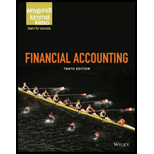
(a)
Bad debt expense:
Bad debt expense is an expense account. The amounts of loss incurred from extending credit to the customers are recorded as bad debt expense. In other words, the estimated uncollectible
Direct write-off method
This method does not make allowance or estimation for uncollectible accounts, instead this method directly write-off the actual uncollectible accounts by debiting bad debt expense and by crediting accounts receivable. Under this method, accounts would be written off only when the receivables from a customer remain uncollectible.
The amount to be reported as bad debt expense, if Company M uses the direct write-off method of accounting for
(b)
The amount of bad debts expense would be recorded by Company M, under allowance method.
Allowance method:
It is a method for accounting bad debt expense, where uncollectible accounts receivables are estimated and recorded at the end of particular period. Under this method, bad debts expenses are estimated and recorded prior to the occurrence of actual bad debt, in compliance with matching principle by using the allowance for doubtful account.
Bad debt expense:
Bad debt expense is an expense account. The amounts of loss incurred from extending credit to the customers are recorded as bad debt expense. In other words, the estimated uncollectible accounts receivable are known as bad debt expense.
(c)
The amount of bad debt expense that would be recorded by Company M.
(d)
To describe: The weakness of reporting bad debt expense under direct write-off method.
Want to see the full answer?
Check out a sample textbook solution
Chapter 8 Solutions
Financial Accounting
- I am looking for the correct answer to this general accounting problem using valid accounting standards.arrow_forwardA company currently has $78 million in sales, $36 million in current assets, $62 million in fixed assets, and $24 million in accounts payable.arrow_forwardPlease provide the solution to this general accounting question with accurate financial calculations.arrow_forward
- I need help finding the accurate solution to this financial accounting problem with valid procedures.arrow_forwardCan you explain the correct methodology to solve this financial accounting problem?arrow_forwardCan you solve this general accounting question with the appropriate accounting analysis techniques?arrow_forward
- Can you help me find the accurate solution to this financial accounting problem using valid principles?arrow_forwardPlease help me solve this financial accounting question using the right financial principles.arrow_forwardI am searching for the accurate solution to this general accounting problem with the right approach.arrow_forward
- Equipment with a cost of $2,340,000 has an estimated salvage value of $73,000 and an estimated life of 5 years or 62,000 hours. It is to be depreciated using the units-of-activity method. What is the amount of depreciation for the first full year, during which the equipment was used for 11,500 hours?arrow_forwardFelicity Systems has net income of $275,000, net sales of $1,950,000, and average total assets of $1,250,000. What is its return on total assets?arrow_forwardWhat is its return on total assets?arrow_forward

 AccountingAccountingISBN:9781337272094Author:WARREN, Carl S., Reeve, James M., Duchac, Jonathan E.Publisher:Cengage Learning,
AccountingAccountingISBN:9781337272094Author:WARREN, Carl S., Reeve, James M., Duchac, Jonathan E.Publisher:Cengage Learning, Accounting Information SystemsAccountingISBN:9781337619202Author:Hall, James A.Publisher:Cengage Learning,
Accounting Information SystemsAccountingISBN:9781337619202Author:Hall, James A.Publisher:Cengage Learning, Horngren's Cost Accounting: A Managerial Emphasis...AccountingISBN:9780134475585Author:Srikant M. Datar, Madhav V. RajanPublisher:PEARSON
Horngren's Cost Accounting: A Managerial Emphasis...AccountingISBN:9780134475585Author:Srikant M. Datar, Madhav V. RajanPublisher:PEARSON Intermediate AccountingAccountingISBN:9781259722660Author:J. David Spiceland, Mark W. Nelson, Wayne M ThomasPublisher:McGraw-Hill Education
Intermediate AccountingAccountingISBN:9781259722660Author:J. David Spiceland, Mark W. Nelson, Wayne M ThomasPublisher:McGraw-Hill Education Financial and Managerial AccountingAccountingISBN:9781259726705Author:John J Wild, Ken W. Shaw, Barbara Chiappetta Fundamental Accounting PrinciplesPublisher:McGraw-Hill Education
Financial and Managerial AccountingAccountingISBN:9781259726705Author:John J Wild, Ken W. Shaw, Barbara Chiappetta Fundamental Accounting PrinciplesPublisher:McGraw-Hill Education





